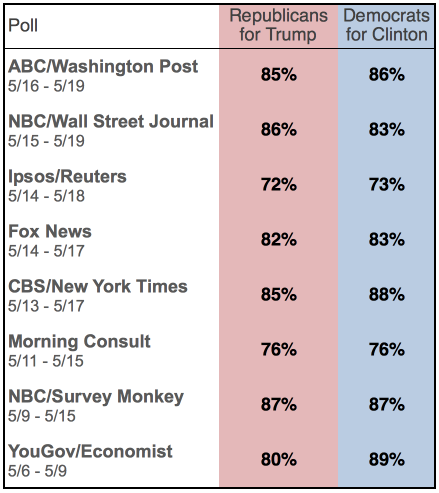Donald Trump is rising in the polls again. We’ve been here before: As the business mogul surged in the Republican primary polls last July, analysts and pundits worked hard to explain his rise while downplaying his long-term chances.
Now Trump is the presumptive Republican nominee, and we’re looking at a similar pattern: Trump’s numbers are creeping upward, and analysts and pundits are explaining why not to trust those numbers. Those criticisms are valid — it is very early, and the Democratic nomination is still not completely settled. A lot can and will happen between now and November.
But there are also indications that the 2016 general election won’t be all that different from the early polls. Republicans will vote for the Republican candidate, Democrats will vote for the Democratic candidate and the election will come down to a handful of battleground states. In short, Trump might fail — his polling bump could be short-lived. He could lose in a close race. But he could also win this election.
Despite the overarching narrative of a fractured Republican Party elite, most national and state-level general election polls are showing that most Republican voters support Trump. The numbers are pretty similar to the proportion of Democrats who indicate they will support Hillary Clinton.
The most recent national polls show nearly identical degrees of support for Clinton and Trump from respondents in their respective parties:

Trump is an unusual candidate in many ways — particularly in his lack of political experience and use of inflammatory rhetoric — but in a choice between Trump and Clinton, Republican voters unsurprisingly favor the Republican candidate.
Another common media narrative that doesn’t play out well in the polls is the idea that a strong third-party candidate would hurt Trump’s electoral chances. Many voters say they would consider a third-party candidate — and respondents say that every cycle— but in tests of that scenario, a strong third-party candidate pulls as many voters from Clinton as from Trump. That could be because the former secretary of state is viewed almost as unfavorably as the former reality TV star.
All of that said, there are indeed substantial reasons to be skeptical of Trump’s chances in the general election. The polls aren’t reflecting divisions in the party right now, but those divisions do exist among donors and high-level party leaders. If House Speaker Paul Ryan (R-Wis.) refuses to back Trump and donors remain resistant, voters might begin to pay more attention to the #NeverTrump wing of the party.
But it’s unclear whether the #NeverTrump faction will hold — Sen. Lindsey Graham (R-S.C.), who once called Trump a “race-baiting, xenophobic, religious bigot,” is rumored to be privately encouraging Trump support. Most of Trump’s other former primary opponents have also caved, although no one in the Bush family is willing to support him.
Trump’s lack of political experience could matter as well. The last time we elected a president without any previous electoral experience was in 1952 with Dwight Eisenhower, who was a very well-known World War II general. Is a celebrity business mogul the new Army general? Time will tell, but the general election campaign could shed more light on Trump’s lack of experience than the primaries did.
Ultimately, whether the general election looks like it usually does — with states splitting along their usual party lines and a handful of battleground states determining the outcome — depends on how strong Republican identity is. So far, it seems the Republican label is serving Trump pretty well, and the voters, at least, are lining up behind him.
If that continues, Trump has a solid chance of winning in enough battleground states to win the presidency. Betting markets, aggregated on PredictWise, give him about a 33 percent chance to win the election, and Clinton a 67 percent chance. That’s probably about right.


